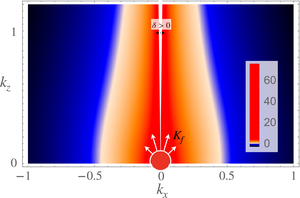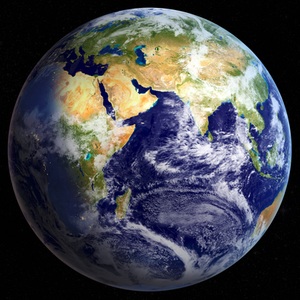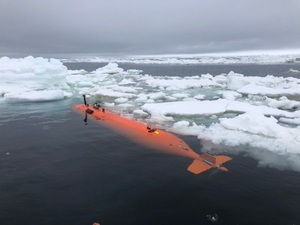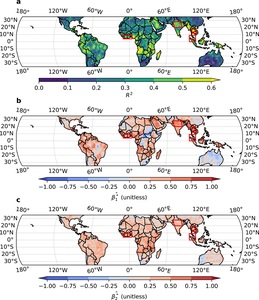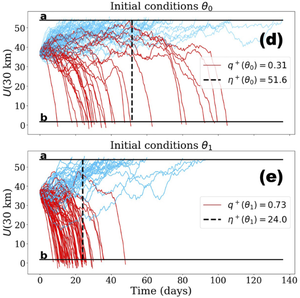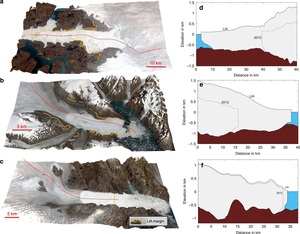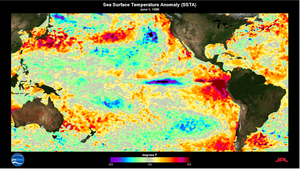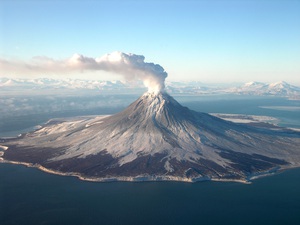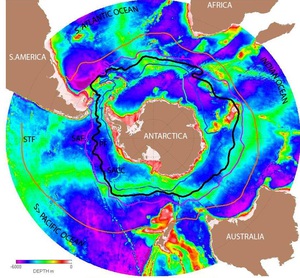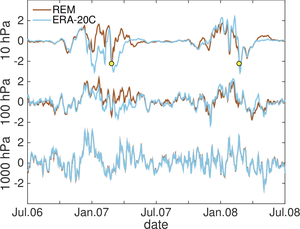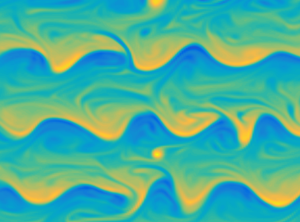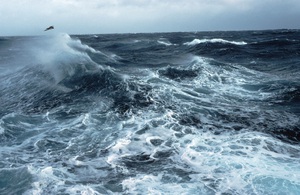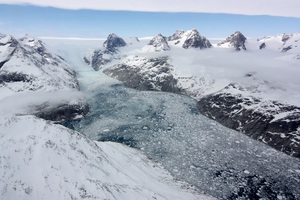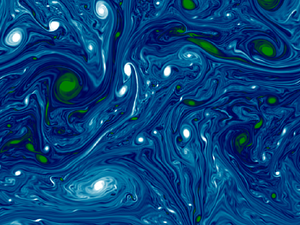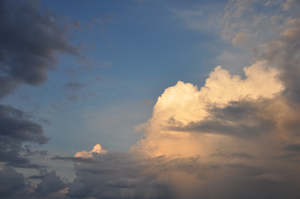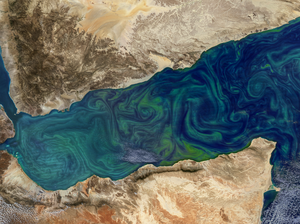News & Research
-
Wave turbulence in the ocean
Feb. 21, 2025Courant instructor Michal Shavit together with professors Oliver Bühler and Jalal Shatah published a paper in Physical Review Letters on a theoretical model for internal wave turbulence in the ocean, a longstanding and difficult problem relevant to vertical mixing in the deep ocean. Their new model goes beyond prior … Read More
-
Two faculty positions available
Nov. 1, 2024The Center for Atmosphere Ocean Science (CAOS) announces the opening of two separate searches for open-rank tenure/tenure-track faculty appointments Read More
-
Scientists Capture New View of How the Ocean Melts Antarctica’s Ice Shelves
Aug. 7, 2024A report on the deployment of autonomous underwater vehicles in Antarctica was published in the New York Times. CAOS professor David Holland was part of the research team, contributing instrumentation through a hot-water drilled hole on an Antarctic Ice Shelf, collecting data coincident with the underwater vehicle, a first-ever feat. The research was also reported in NYU News. Read More
-
Forecasting heat stress months in advance from the current state of ENSO
Aug. 5, 2024 -
ClimSim: An open large-scale dataset for training high-resolution physics emulators
Jan. 24, 2024CAOS Professor Laure Zanna served as a co-author of "ClimSim: A large multi-scale dataset for hybrid physics-ML climate emulation" which won an Outstanding Paper Award at the NeurIPS 2023 Conference in New Orleans. You can read more about their progress here. Read More
-
CAOS Professor Interviewed by the New York Times Magazine
Jan. 7, 2024CAOS Professor David Holland was interviewed for an article in the latest issue of the New York Times Magazine on an ambitious new plan to save the Jakobshavn glacier in Greenland. You can read the full article here Read More
-
Machine learning connects satellinte measurements to ocean velocity fields
Dec. 23, 2023CAOS PhD Qiyu Xiao, Professor Shafer Smith, and collaborators published a paper utilizing neural networks to convert sea surface heights observation to velocities. This work is featured in EOS and NASA. Read More
-
Faculty position joint between CDS and CAOS
Nov. 14, 2023The Center for Data Science and the Center for Atmosphere Ocean Science seek candidates for one (1) open-rank joint faculty position, anticipated to begin in September 2024. We seek to develop our strength at the interface between machine learning and science, leveraging advances in data science. Read More
-
High resolution simulations reveal the impact of frequency bandwidth on a one-dimensional model for wave turbulence
Sept. 11, 2023CAOS PhD student Ryan Shìjié Dù and professor Oliver Bühler have published a paper bridging the theory and simulation gap of a one-dimensional model for wave turbulence, the MMT model. Read More
-
M²LInES can now demonstrate the impact of data-driven Machine Learning parameterizations in global models
Sept. 7, 2023M²LInES can now demonstrate the impact of data-driven Machine Learning parameterizations in global models! You can read about new generation of climate models with AI in this new article by Professor Zanna. Read More
-
Idealized study of how moisture impact the midlatitude atmosphere
April 12, 2023Marguerite Brown, Olivier Pauluis, and Edwin Gerber recently investigated how moisture gradients and latent heat release impact the energetics of the midlatitude atmosphere using an idealized two-layer model of the midlatitudes with simplified moist thermodynamics. As the moisture content of the atmosphere is expected to increase under climate change, a better understanding of the impact of moisture is necessary to reduce uncertainty about how weather patterns will change. Read More
-
Emergence and sensitivity of hurricane-like vortices in an idealized atmosphere
Feb. 13, 2023Mu-Hua Chien, Olivier M. Pauluis, and coauthors investigated the emergence and sensitivity of hurricane-like vortices in a numerical simulation of an idealized atmospheric system. Read More
-
Multiple faculty positions in Climate and Mathematics at Courant
Oct. 27, 2022CAOS seeks candidates for several open-rank faculty positions, anticipated to begin September 2023. We aim to fill core faculty positions in the CAOS group, as well as two new multi-department cluster positions under the initiative Predicting Climate Change and its Impacts: From the Global to Urban Scale that seeks to create a diverse, inter-disciplinary cohort to devise cutting edge research and curricular development at NYU. Read More
-
A novel prediction framework to forecast extreme meteorological events
Nov. 4, 2021Jonathon Weare and Ed Gerber with a graduate student at the University of Chicago: Justin Finkel just published a study adopting a novel prediction framework from computational chemistry to forecast extreme meteorological events. The paper is published in Monthly Weather Review. Read More
-
Faculty position in Climate and Mathematics at Courant
Oct. 6, 2021CAOS seeks candidates for an open-rank faculty position at the intersection of climate science and mathematics, anticipated to begin in September 2022. This search is part of a multi-department cluster hire in Predicting Climate Change and its Impacts: From the Global to Urban Scale that seeks to create a diverse, inter-disciplinary cohort to devise cutting edge research and curricular development. Read More
-
NYU to Join NSF-Backed AI-Based Climate Modeling Center
Oct. 1, 2021New York University will join a new, NSF-supported center, Learning the Earth with Artificial Intelligence and Physics (LEAP), that will develop the next generation of data-driven, physics-based climate models. Zanna, a co-director of LEAP’s research arm, and her NYU colleagues will focus specifically on machine learning models for ocean processes. Read More
-
Andrew Majda, 1949-2021
April 16, 2021 -
Centennial response of Greenland’s three largest outlet glaciers
Jan. 5, 2021David Holland and colleagues have used historical photographs to extend the climate record of ice loss in Greenland back beyond the modern satellite era to almost a century and a half ago. The study significantly improves the temporal resolution of ice loss during that period showing a complex multi decadal pattern of increased and lessened loss rates. Read More
-
Heat and carbon coupling reveals ocean warming due to circulation changes
Sept. 23, 2020Laure Zanna and Ben Bronselaer developed a new method to analyze the global uptake of heat and carbon in the ocean. Their results show that ocean warming patterns will increasingly be influenced by simple uptake of atmospheric warming, making them easier to predict. This is in contrast to the past 60 years, over which time circulation changes have been viewed as key factors in shaping ocean warming patterns. Read More
-
Statistical forecasting of the El Nino Southern Oscillation
Feb. 25, 2020CAOS researchers Xinyang Wang and Dimitris Giannakis in collaboration with Joanna Slawinska of University of Wisconsin-Milwaukee have developed a data-driven technique for statistical forecasting of the El Nino Southern Oscillation (ENSO), based on a combination of kernel methods for machine learning with techniques from operator-theoretic ergodic theory. Read More
-
Untangling waves and vortices from limited observations
Feb. 6, 2020CAOS researchers H. Wang and O.Bühler have developed a numerically robust algorithm to decompose the 1-D energy spectra obtained from ship/aircraft data sets. This work is featured in Focus on Fluids by Journal of Fluid Mechanics. Read More
-
Predicting fluids flows from Lagrangian drifter observations
Oct. 30, 2019Courant researchers M. A. Mohamad and A. J. Majda studied how Lagrangian observations can be used to recover Eulerian properties of a fluid flow using data assimilation techniques. They show how exact and approximate algorithms, which combine observations with a model, can be used to predict Eulerian properties of the flow field.
Thumbnail: NASA Earth Observatory Read More -
A flux-balanced fluid model for plasma edge turbulence with coherent zonal jet creation
June 12, 2019Courant researchers A. J. Majda, D. Qi, and A. J. Cerfon propose a flux-balanced model to improve the understanding of plasma edge turbulence and creation of zonal structures and develop a theory to address the generation and persistence of large-scale coherent flow structures in these models. Read More
-
Upscale Impact of Mesoscale Convective Systems and Its Parameterization in an Idealized GCM for an MJO Analog above the Equator
April 22, 2019A recent study by CAOS researchers Qiu Yang and Prof. Andrew Majda in collaboration with Mitchell W. Moncrieff from NCAR investigates the upscale impact of mesoscale convective systems (MCSs) on the Madden-Julian Oscillation (MJO) in an idealized GCM. Read More
-
Reconstructing dynamics of chaotic systems using approximate eigenfunctions
March 22, 2019A recent study by Suddhasattwa Das, Dimitrios Giannakis, and Joanna Slawinska investigates a phenomenon / object called approximate eigenfunctions to forecast dynamics of chaotic systems over arbitrary time scales. Read More
-
Understanding the atmospheric response to volcanoes
Feb. 7, 2019Recent work by CAOS researchers Kevin DallaSanta and Ed Gerber with Matthew Toohey (GEOMAR Kiel) investigates the influence of volcanic eruptions on weather and climate using a hierarchy of models of varying complexity. Read More
-
Revealing the propagation characteristics of the Antarctic Circumpolar Wave and its teleconnection with the El Nino Soutern Oscillation
Jan. 3, 2019Researchers at CAOS and UWM have studied the Antarctic Circumpolar Wave (ACW) in model and observational data via advanced data analysis techniques. The study has produced a decomposition of the ACW in terms of coherent spatiotemporal modes, some of which exhibit strong teleconnections with the El Nino Southern Oscillation. Read More
-
What limits our ability to characterize the variability of the large scale circulation of the extratropics?
Dec. 3, 2018Courant faculty Dr. Edwin P. Gerber and Patrick Martineau (University of Tokyo) explore how dominant modes of atmospheric variability in the extratropics can be constrained with atmospheric reanalyses. Research finds the spread between reanalyses to be much less than the sampling uncertainty associated with the finite length of reanalysis records. Read More
-
Strategies for Predicting Statistical Responses in Complex Turbulent Systems
Nov. 5, 2018CAOS researchers have developed a general mathematical framework to construct statistically accurate reduced-order models that have skill in capturing the statistical variability in the principal directions with largest energy of a general class of damped and forced complex turbulent dynamical systems. Read More
-
Modeling Ocean Uptake in an idealised Southern Ocean
Nov. 2, 2018CAOS researchers in collaboration with researchers at Columbia University have investigated tracer fluxes and ocean upwelling in an idealized southern ocean model. The study finds the tracer fluxes to be sensistive to the vertical resolution, despite the reduction in the depths of the vigorously mixed boundary layers. Read More
-
Modeling the mélange
July 2, 2018Icebergs are formed by calving, a natural process during which the ends of marine terminating glaciers break off and fall into the ocean. In Greenland, glaciers often terminate in narrow fjords with complex geometries, in which large iceberg becomes stuck for many months, freeze together, and form a sea-ice/iceberg mixture … Read More
-
Unlocking the Kolmogorov code of turbulence
July 2, 2018Atmosphere and ocean flows present us with a complicated jigsaw puzzle of energetic motions on many scales, ranging from slow planetary waves on scales of 10,000 kilometers or so all the way down to small-scale three-dimensional turbulence, where dissipation of kinetic energy might take place on a scale of just … Read More
-
What controls moisture above the clouds?
May 10, 2018CAOS researchers developed a new model of a moist world to explore the role of the tropical tropopause layer in regulating stratospheric water vapor. Read More
-
Oxygen, turbulence, and life in the oceans
May 9, 2018CAOS researchers in New York and Abu Dhabi are exploring the complex interaction between turbulent ocean transport, biological interactions and oxygen in the Indian Ocean. Read More



